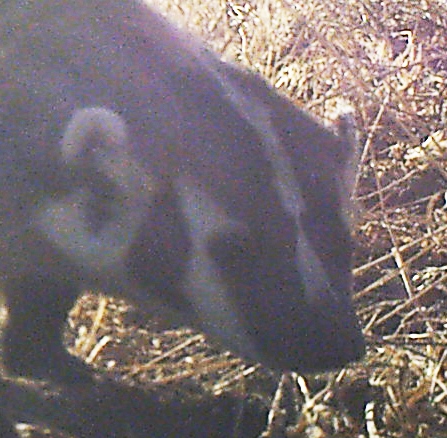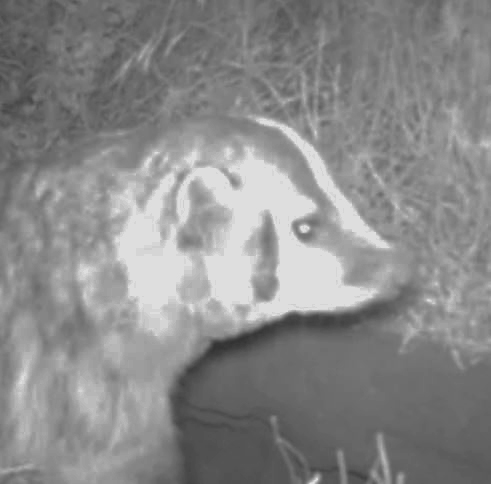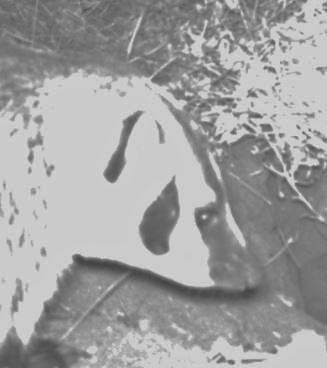
Badger Research
Badgers Are Finally Back at Volcan Mountain!
Check in periodically for ongoing conservation research information around the Volcan Mountain range.
November 7, 2014 - 2:23pm (see August 2016 update & pix below)
Since 2011 scientists with the US Geological Survey (USGS), with grant funding from the SANDAG TransNet Environmental Mitigation Program (EMP), have been conducting Badger Conservation Research in watersheds connected to the Volcan Mountain range, including along the San Diego and San Dieguito River watersheds. Cheryl Brehme, biologist with the USGS Western Ecological Research Center (WERC) is leading the research and is partnering with Heath Smith, Program Coordinator and handler with the Conservation Canines program out of the University of Washington, and his badger-sniffing Australian cattle dog, Pips.
They recently released a 2 1/2 minute video featuring the summit of San Diego County's Volcan Mountain Wilderness Preserve (VMWP) in their research. (Click here to see the video). The Volcan Mountain Foundation (VMF) is seeking volunteers interested in wildlife monitoring with VMF's Wildlife Imaging Team (WITs). Click here to become a WITs volunteer!
According to Brehme, “This badger research is important because it’s part of a broader effort to measure the success of regional initiatives to preserve and link wildlife habitat. Badger movements are a good indicator of the wildlife connectivity of upland habitats.” Recently a significant badger population has been identified on part of the Volcan Mountain Wilderness Preserve.
Link to 2014 USGS-WERC American badger research report
The researchers are trying to find out more about their status, and where they’re moving among the preserves in the County. Most San Diegans might not think that badgers live in their region. These furry-striped creatures do live here, but they’re rarely seen. Badgers are listed by the California Department of Fish & Wildlife (CDFW) as a species of special concern and very little is known about them. They can travel up to 6 miles a day. It’s the first regional study of its kind. From the research they to seek to identify the location, movement and habitat use of these elusive creatures in San Diego County.
Pips (sometimes called Pipsqueak) is a specially-trained dog, who uses his wonderfully sensitive nose to track scents and signs of badgers. He has found badger scat in burrows. Smith noted that, “Pip can use the wind to his advantage to pick up odors that are moving through the wind, through the environment, then he works into the source of that odor, and then he’ll sit when he finds a sample.” Heath then confirms the sample.
Form the burrows, scientists collect badger hair samples and run DNA analyses to gauge population trends. While there’s plenty of evidence that badgers do live this region, the challenge is to capture images of these elusive creatures, which so far have escaped detection by motion sensor cameras.
The researchers are seeking 'citizen scientists' to be on the look out for badgers signs or sightings. If you happen to see a badger, please notify the USGS or email your sightings to SDbadgers@usgs.gov. For more information go to: www.werc.usgs.gov/sdbadgers.
Update: August 30, 2016
 Researcher, Cheryl, Brehme, with the USGS Western Ecological Research Center (WERC), reports that badgers are finally back at Volcan Mountain! These elusive creatures were here for about a week or so before moving on, and likely traveled long distances to find each other and mate.
Researcher, Cheryl, Brehme, with the USGS Western Ecological Research Center (WERC), reports that badgers are finally back at Volcan Mountain! These elusive creatures were here for about a week or so before moving on, and likely traveled long distances to find each other and mate.
Since first recording badger activity (but no actual badgers) in April & May 2014 with Pips, the badger-sniffing dog, and his handler, Heath, there has been zero badger activity...until now--August 2016! Wow, what patiene these researchers have.
Cheryl, and her research partner, Devin, were able to identify three individual badgers by differences in facial markings--Notch, Sideburn and LongNose--and they recorded the following activity:
 A badger was recorded digging out a burrow on Aug. 9- could not identify (no face shot)
A badger was recorded digging out a burrow on Aug. 9- could not identify (no face shot)- On Aug. 12, Notch was detected and appeared to be scent marking outside of the burrow
- On Aug. 13 at 6AM, Sideburn was detected outside the same burrow (appears young)
- On Aug 13 evening, LongNose was recorded (video and pics) at both burrows
- A badger walked passed the burrows on Aug. 15- could not identify (no face shot)
- No activity since
 Cheryl also noted that it is breeding season for the American badger, and that they have received more reports through the hotline as well. If you have recently seen a badger, fresh burrows, or (yes) a dead badger, you can help this important research work by reporting it.
Cheryl also noted that it is breeding season for the American badger, and that they have received more reports through the hotline as well. If you have recently seen a badger, fresh burrows, or (yes) a dead badger, you can help this important research work by reporting it.
Phone: 619-225-6458; email: SDBadgers@usgs.gov and learn more at www.werc.usgs.gov/sdbadgers
Thanks to USGS-WERC for sharing the wonderful pix!